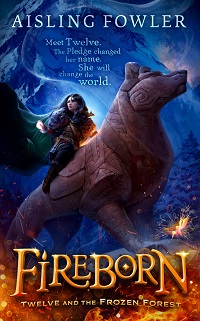 Jennifer Lau
Jennifer LauThis article is in the Featured Author and Interviews Categories
Fireborn: An Interview with Aisling Fowler
There’s a proper buzz around Fireborn, the hot new children’s fantasy series of 2021. Rights sold to twenty different territories and to HarperCollins Children’s Books for a record-breaking sum. Reading book one, it’s easy to understand the excitement. Set in a well-imagined prehistoric world, it has a particularly charismatic heroine in Twelve. Twelve is a Huntling, in training to become a Hunter and pledged to serve the seven clans as a warrior. Full of rage and guilt following the massacre of her family, she is determined to remain friendless and to dedicate herself to revenge. But when the Hunting Lodge is attacked by goblins and the only person she cares about is kidnapped, Twelve sets out on a rescue mission. She’s joined on the quest by Dog, the Lodge’s huge living stone guardian, and by the two boys she likes least, Five and Six. Together this ill-assorted band face multiple dangers and an array of terrifying monsters, slowly learning more about themselves and each other in the process. Full of adventure and incident, but packing a genuine emotional punch too, it’s an unputdownable read.
 Books for Keeps caught up with author Aisling Fowler shortly before publication, and she is still at the stage where, ‘it feels very new and surprising when someone says they like the book. I was working on it for years, and now it’s out in the world, I just feel very lucky.’ Aisling had always wanted to write – in fact she sent a story to Puffin as a child – but, as a teenager, exams and other demands took over. ‘I forgot how much I enjoyed writing’ she says. Then, aged 29, came a light bulb moment. ‘I was retraining as a nurse, and I met this lovely girl on my course who was writing in her spare time. She asked me to read the manuscript of a book she was working on, which I did, and it reminded me that writing was something I had loved. When I say I didn’t write in that period, every now and then I’d have an idea and jot it down, but I didn’t prioritise it or make the time for it. Meeting Phoebe really opened my eyes to the fact that it’s not about having ideas. You have to sit down and actually do the work. From the day she gave me her manuscript I started to trying to do that, make the time for it.’
Books for Keeps caught up with author Aisling Fowler shortly before publication, and she is still at the stage where, ‘it feels very new and surprising when someone says they like the book. I was working on it for years, and now it’s out in the world, I just feel very lucky.’ Aisling had always wanted to write – in fact she sent a story to Puffin as a child – but, as a teenager, exams and other demands took over. ‘I forgot how much I enjoyed writing’ she says. Then, aged 29, came a light bulb moment. ‘I was retraining as a nurse, and I met this lovely girl on my course who was writing in her spare time. She asked me to read the manuscript of a book she was working on, which I did, and it reminded me that writing was something I had loved. When I say I didn’t write in that period, every now and then I’d have an idea and jot it down, but I didn’t prioritise it or make the time for it. Meeting Phoebe really opened my eyes to the fact that it’s not about having ideas. You have to sit down and actually do the work. From the day she gave me her manuscript I started to trying to do that, make the time for it.’
A sabbatical from nursing gave her further impetus, ‘I basically said to myself, if you can’t finish a full draft of a book when you have no other time pressures, then you’re never going to be able to do it, so you’re not allowed to write any more. It’s now or never!’ The ultimatum worked and she completed the first draft of the first book.
The story went through lots more drafts before she decided to submit it to agents, and she clearly enjoyed the rewriting process, particularly in the way it deepened her understanding of the characters, ‘I went into book one thinking I had the whole story totally plotted out and that I knew exactly what was going to happen, and obviously I didn’t at all! I hadn’t done that really detailed plotting as to when key conversations were going to happen or those breakthrough moments in relationships. So on the page it went off in its own direction. By the time I finished the first draft, I knew the characters so much better, and I could see I hadn’t known them so well at the beginning, so there was quite a lot of rewriting.’
 She talks about her characters with genuine affection, particularly Twelve, who is the starting point for everything. ‘She was the first character to come to me and one of the first things I knew about her was that she was full of anger. She has these very thick defensive walls, she doesn’t let people in easily and she’s really quite an isolated character at the start of the story and appears very prickly to everyone around her, apart from Widge.’ Widge is Twelve’s pet squirrel and a wonderful character in his own right. Twelve’s personality shaped Aisling’s creation of the book’s other protagonists too, ‘I knew that no matter what other characters I put around her, she probably wouldn’t get on with them and I thought if that’s going to be the case, then I might as well make them as mismatched as possible.’ Dog, the magical living stone guardian who is with Twelve from the beginning of her quest apparently started off as multiple guardians, before she condensed him down into one. ‘I thought why not give him the qualities of a dog – make him dutiful, loyal and protective – but I was also quite aware that I’d created this old, powerful character and I didn’t want him to take over the story because when you have a character like that, if you’re being true to them, they probably wouldn’t need all these children around them, they’d go off and do the thing themselves! I tried to make it clear that he’s quite out of his comfort zone and he’s certainly never had to take responsibility for a bunch of bickering children before so he’s not quite as confident as he would normally be.’ As for Twelve’s human companions, Five and Six, ‘I knew I wanted them to be best friends and have this really strong relationship but also be opposites. Five is really antagonistic towards Twelve but I find him interesting because in some ways he’s a little bit similar to her, though they’d never acknowledge that. He’s got the same defensive wall, but it comes over as snarky, covering for a lack of confidence, and he’s got secrets that he’s hiding from the group. And then there’s Six, on the surface he’s the most straightforward character, but he’s got secrets he’s keeping too – and out of the group is the best at that.’
She talks about her characters with genuine affection, particularly Twelve, who is the starting point for everything. ‘She was the first character to come to me and one of the first things I knew about her was that she was full of anger. She has these very thick defensive walls, she doesn’t let people in easily and she’s really quite an isolated character at the start of the story and appears very prickly to everyone around her, apart from Widge.’ Widge is Twelve’s pet squirrel and a wonderful character in his own right. Twelve’s personality shaped Aisling’s creation of the book’s other protagonists too, ‘I knew that no matter what other characters I put around her, she probably wouldn’t get on with them and I thought if that’s going to be the case, then I might as well make them as mismatched as possible.’ Dog, the magical living stone guardian who is with Twelve from the beginning of her quest apparently started off as multiple guardians, before she condensed him down into one. ‘I thought why not give him the qualities of a dog – make him dutiful, loyal and protective – but I was also quite aware that I’d created this old, powerful character and I didn’t want him to take over the story because when you have a character like that, if you’re being true to them, they probably wouldn’t need all these children around them, they’d go off and do the thing themselves! I tried to make it clear that he’s quite out of his comfort zone and he’s certainly never had to take responsibility for a bunch of bickering children before so he’s not quite as confident as he would normally be.’ As for Twelve’s human companions, Five and Six, ‘I knew I wanted them to be best friends and have this really strong relationship but also be opposites. Five is really antagonistic towards Twelve but I find him interesting because in some ways he’s a little bit similar to her, though they’d never acknowledge that. He’s got the same defensive wall, but it comes over as snarky, covering for a lack of confidence, and he’s got secrets that he’s hiding from the group. And then there’s Six, on the surface he’s the most straightforward character, but he’s got secrets he’s keeping too – and out of the group is the best at that.’
Her characters face tough physical tests through their encounters with the deadly creatures they meet on their search for kidnapped Seven. (Aisling loved that aspect of the book: ‘The more monstrous the creature, the more pleased with myself I felt!’) but she also puts them through a devastating psychological test. In the book’s key scene, deep in the Frozen Forest, our heroes encounter Oakhammer, the Heart Tree, powerful, frightening, a mix of mischief and malevolence. Oakhammer offers crucial information but in return for truths from each of them, and the secrets they are forced to reveal threaten to destroy their nascent friendship and the trust they have established. Combined with Twelve’s overwhelming guilt at not being able to protect her family when their village was attacked, this sense of betrayal and subsequent recovery, give the book a darkness and depth that carry considerable weight.
Twelve survives the experience, and indeed emerges stronger, finally able to accept who she is and, more important still, to choose who she is going to be. It’s empowering, and Aisling is full of admiration for Twelve, ‘I often think why can’t I be more like this character I’ve created and not care what people think, do what I know is right, be more assertive?’ She would have loved to read a character like Twelve when she was younger, ‘I hope that if there are any young kids reading the book the message will get into their heads – you don’t have to be smile and be nice all the time, it’s OK to speak up and stand up for what you believe in. I would love it if that was one of the side effects of the story.’
Fireborn: Twelve and the Frozen Forest by Aisling Fowler, illus by Sophie Medvedeva, is published by HarperCollins Children’s Books, 978-0008394158, £12.99 hbk.




 Marcus Duran
Marcus Duran Charlotte Knee
Charlotte Knee